7 Popular Planter Materials to Use Indoors or Outdoors
Pros and cons of each material to help you decide which is best
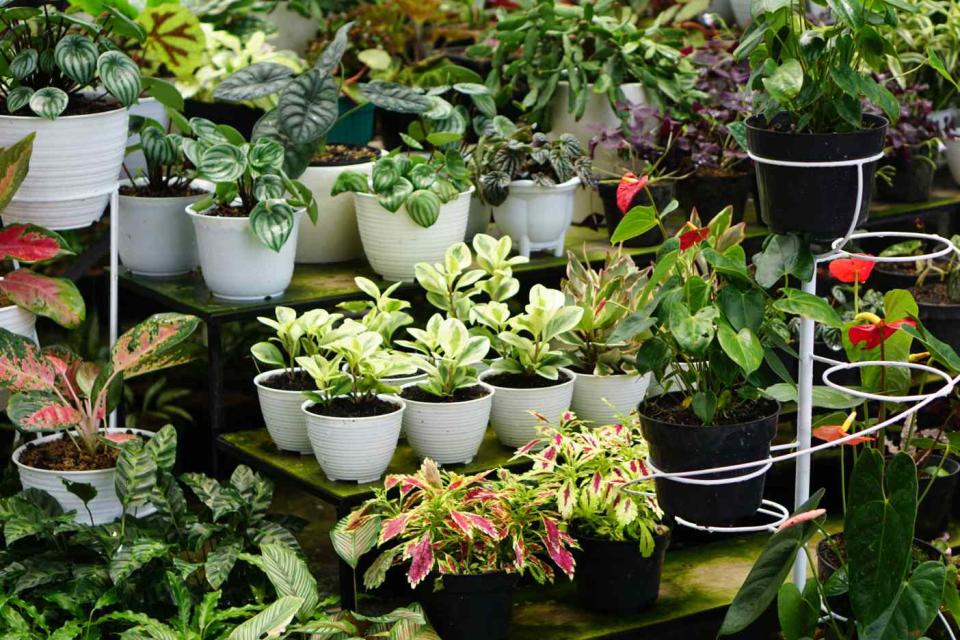
The Spruce / Gyscha Rendy
Fact checked by Alexandra Kay
Whether you are repurposing old containers for use as planting pots or buying containers designed for that purpose at a garden center, planter materials generally fall into seven broad types. Each type of planter material has its advantages, drawbacks, and handling tips. Note that many planters designed for indoor use will not have drainage holes, or if they do, there should be a saucer to catch the water.
Terracotta or Ceramic Pots
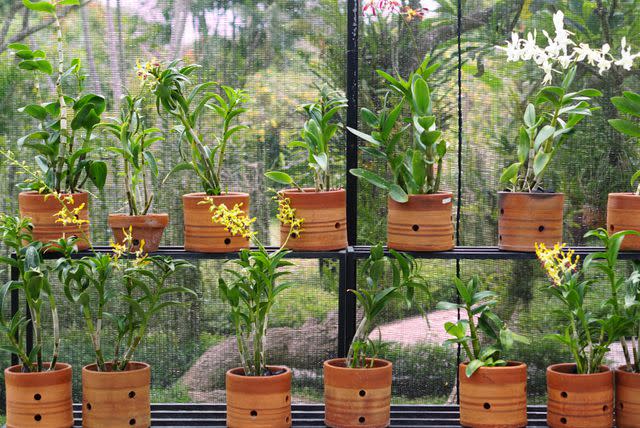
The Spruce / Gyscha Rendy
Several different clay-based materials are used for planting pots. The term terracotta (the term means "baked earth" in Italian) generally refers to an unglazed, somewhat porous ceramic made from clay. These are the familiar reddish-brown clay pots that are popular planting containers. Some terracotta has a glazed surface on the inside.
Traditional ceramic containers are also used as plant pots. Ceramic pots tend to be made of denser, less porous earthen materials, and they are always glazed, both inside and out. All these types of ceramics have similar properties when used as planting containers.
Advantages
Terracotta pots are classic planting pots, with a neutral and warm color that makes almost any plant look great.
The range of quality and cost of terracotta pots is huge—from super cheap to phenomenally expensive. There are many Italian terracotta pots with exquisite hand-painted designs, too.
High-end ceramic pots are very durable. Glazed ceramics can last for decades.
Disadvantages
Ceramic and terracotta pots are quite heavy, especially when filled with soil. Large pots can be lightened by filling the bottoms with empty, sealed plastic bottles before filling them with potting soil.
Terracotta and ceramic pots are brittle, and will almost always break if you drop them.
The inexpensive forms of terracotta are delicate and will not survive repeated freezing and thawing. Under the impact of weather, the clay may begin to flake and slough away.
Terracotta that is not lined or sealed on the inside can dry out quickly once it is filled with soil. That's because clay is a porous material that breathes and allows moisture to easily escape.
Tips
Line inexpensive terracotta pots with heavy plastic and cut a drainage hole in the bottom to protect the clay and prolong the life of the pot.
Look for glazed ceramic or terracotta pots that are glazed on the inside so that the interior surfaces are shiny, less prone to drying out, and also more durable.
Use the terracotta pot as an outer container and insert an inexpensive plastic pot to hold the soil and moisture for your plant. If it's not a perfect fit, you can hide the plastic edge of the inner pot with moss or cascading plants.
If you live in a cold climate, store your terracotta indoors and out of the weather, unless they are rated as frostproof (most are not).
You can leave terracotta pots outside if you empty them and protect them from moisture.
Stack terracotta pots in graduated sizes for a great-looking planter and to maximize vertical growing space.
Wooden Containers
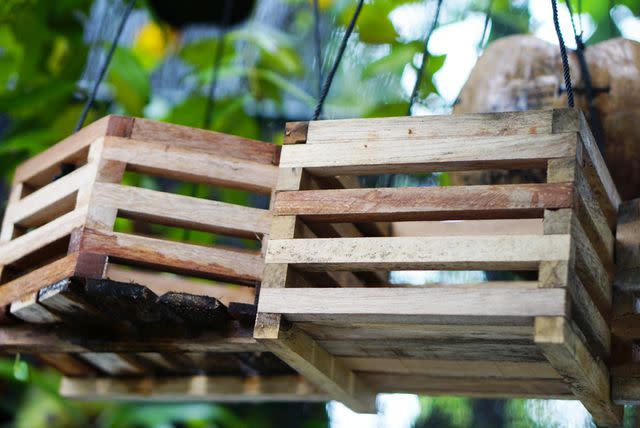
The Spruce / Gyscha Rendy
Wood is a natural building material that is gorgeous when used in planting pots and containers. Styles can range from super modern to traditional, and sizes are equally varied. If you need a custom-size container to fit a specific area or need it to match a color, wood may be the least expensive and easiest choice. Made from the right type of wood, properly constructed, and well-maintained, a wooden planting pot can last for many years. Consider the following woods for planters:
Cedar is a long-lasting but relatively expensive wood commonly used in planting containers.
Redwood has similar properties of cedar but is somewhat more expensive.
Teak will also last when subject to outdoor environments.
Pine is inexpensive but generally will not last as long unless it has been pressure-treated with preservation chemicals.
Advantages
Constructing wooden planting containers is a relatively easy DIY project, requiring ordinary tools and materials.
Wooden containers can be considerably less expensive than high-end terracotta or ceramic pots, especially if you build them yourself.
Many ordinary wooden containers, such as wine boxes and small storage boxes can be repurposed as planting containers.
Disadvantages
If not cared for properly, a wooden container may decay in just a year or two. To avoid decay, the soil should be removed when storing the pot for the winter.
Wooden containers are somewhat high-maintenance, as the wood needs to be resealed periodically to prolong the life of the pot.
Tips
Consider using wooden dresser drawers as planting containers. Either use the drawers separately or keep them in the dresser and pull them out in a graduated pattern (the lowest drawer out the farthest, the top drawer out pulled out the least) to make a large vertical garden.
Line wooden containers with heavy plastic to make them last longer. Use heavy-duty plastic bags with holes cut in the bottom for drainage to line the container, then fill it up with planting soil and plant the specimens. Cut off the top of the plastic bag and tuck in the edges under the soil.
Painting wooden containers with bright colors is a great way to add color or a focal point to your patio, yard, or garden.
Buy old wooden crates at yard sales or flea markets to use as planting pots. But be cautious of old painted wood, as the paint may contain lead, which is dangerous and hard to get rid of.
To help your wooden container last longer, use pot feet to elevate it, so it's not sitting right on the ground or patio.
Empty the container at the end of each growing season, clean and reseal the wood (especially the inside), and store it in a dry location over the winter.
Screws, nails, and other fasteners used to construct wooden planting containers should be made of stainless steel or another corrosion-resistant metal.
Metal Planters
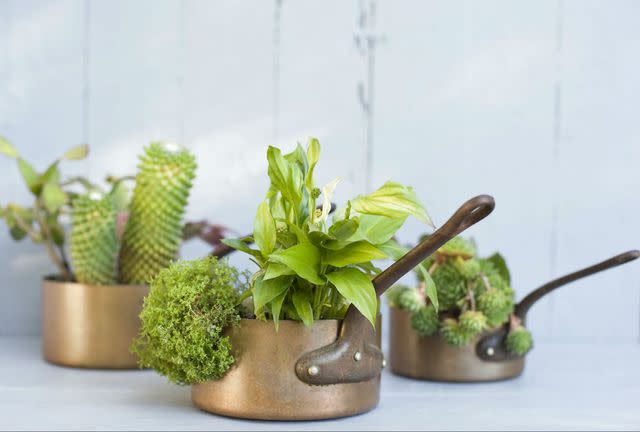
Metal containers can look fabulous indoors or out. From giant feed troughs and brushed modern steel boxes to tin cans, there are many looks and styles of metal containers. A re-purposed file cabinet can even become a good planting container. Painted, brushed, or shiny metal surfaces can all work.
Advantages
Metal planting containers are unusual choices that create a unique look in the garden and often serve as accent pieces.
Many old metal items are available that can be repurposed as planting containers.
Metal containers often develop a wonderful worn patina as they sit out in the weather. A copper pot, for example, may develop an attractive green finish over time.
Although they gradually rust or corrode, metal containers often last for many, many years.
Metal containers are ideal for indoor planters because they usually do not have drainage holes, though you will need to keep an eye on watering.
Disadvantages
Metal can get searingly hot in the sun, which can burn your plants and dry out the soil quickly. Use metal containers only in shady locations to reduce heat and glare. In cooler regions, line your metal containers with bubble wrap to insulate the soil and roots from the hot metal. In hot climates, however, the metal may get hot enough to melt the bubble wrap. Choose plants that are well-suited for hot conditions, such as desert succulents and others that like dry, hot soil.
Tips
Use metal containers as cachepots, using either fiber or plastic containers and setting them inside the metal container.
Use a can opener, or pound in holes in the bottom of the pot using an awl or large nail to assist drainage. The more holes, the better
Go to a hardware or feed and farm store to find large and relatively inexpensive large containers.
Collect plant colanders, old barbecue grills, pretty metal cans, and other found or inexpensive metal containers to use for planting.
If you have a metal mesh container, you can use either plastic or moss to line it. If using plastic, make sure to cut some drainage holes.
Plastic Plant Pots
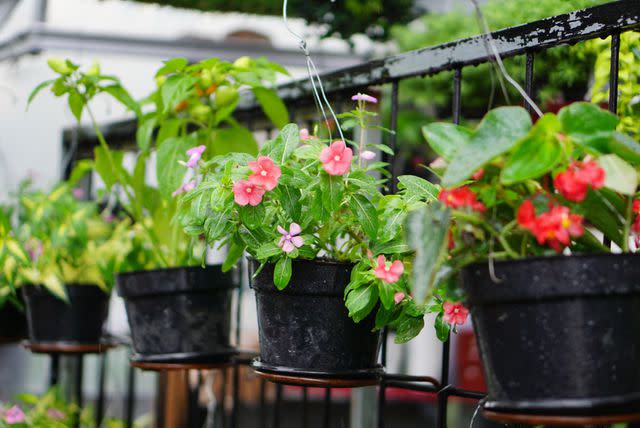
The Spruce / Gyscha Rendy
Plastic as a material for planting containers is uniquely diverse. Some plastic pots are remarkably attractive and high-end, while other plastic containers are basic and plain. But whether you obtain a premium decorative foam plastic pot from a top-end garden center, or just repurpose a 5-gallon pail that once held bird seed, plastic planting containers are always practical for indoor and outdoor use.
Purchased plastic pots are lightweight and can be any shape and style. Ranging from traditional to modern, they can even mimic stone, concrete, and terracotta. They can have patterns, use finishes ranging from matter to high-gloss, and be any color you want.
Advantages
Plastic pots are extremely lightweight.
These are among the least expensive plant pot materials.
No material is more diverse than plastic; you can find hundreds of options when choosing plastic pots.
Plastic pots are fairly resilient to damage. They may resist cracking, even when dropped.
Disadvantages
Inexpensive plastic pots can fade and turn brittle in the sun; they may crack when they age.
Unless they are high-end, plastic pots look like plastic, which means they can have a cheap feel.
Use caution if growing edibles in plastic pots. Some studies show that some plastics can leach chemicals into the soil, particularly if left in the sun. Look for food-grade plastics for growing edibles. Many planters designed for edibles are made of stable plastic that won't leach, such as Earthboxes and Grow Boxes.
Tips
Old, faded plastic pots can be painted with an outdoor spray enamel to renew them.
Old plastic pots can become liners for use in terracotta and metal planting containers.
Plastic polish can be used to restore the gloss on plastic pots that have dulled in the sun.
Fiberglass Containers
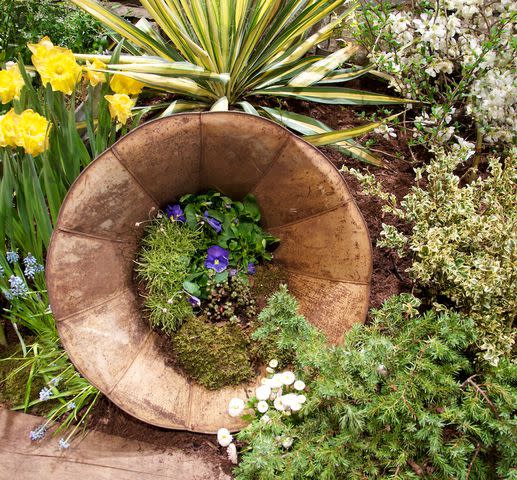
Often mistaken for plastic because they are equally lightweight, fiberglass planting pots are also synthetic. But rather than being made of molded plastic, they are formed from fiberglass fibers mixed with resins that are formed into various shapes. At first glance, fiberglass containers may even be mistaken for concrete, terra cotta, or even wood, since the versatility of this material is incredible.
Advantages
These elegant planting containers are suitable for designer gardens or can easily integrate with your decor when used for indoor houseplants.
Fiberglass is a much lighter material than clay or ceramics.
These pots are particularly durable. Unlike clay, which gradually breaks down under weather, fiberglass pots can last almost indefinitely.
Disadvantages
These can be expensive containers, costing nearly the same as high-end ceramic pots.
The fiberglass fibers can wear and fray over time, giving the pots a ragged appearance. Harsh power washing can also damage them.
Tips
Clean out, hand-wash, and store your fiberglass pots at the end of each garden season. While they can survive the winters outdoors, they will last longer if protected for the winter.
With large containers, position them in their final location before filling them with soil. If the pot will be moved around, fill the bottom with a layer of empty sealed plastic bottles to lighten the weight.
Elevate the bottom of the container on pot feet to allow for drainage.
Concrete and Hypertufa Planters
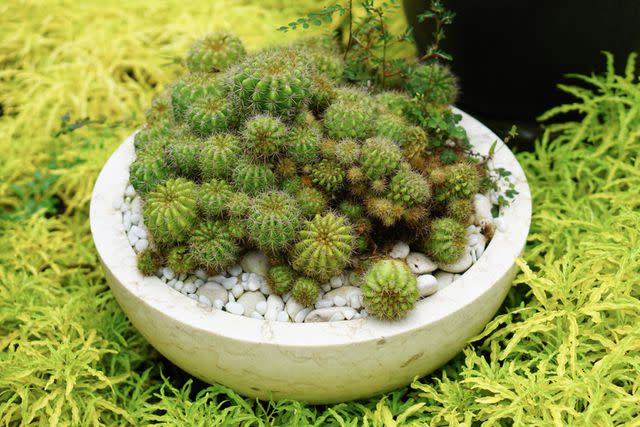
The Spruce / Gyscha Rendy
Some of the most beautiful outdoor containers are made of concrete. The colors and shapes can be elegant and nuanced. The only drawback is weight—they can be ridiculously heavy. Hypertufa has some of the looks of concrete but is lighter.
Hypertufa is a lightweight concrete that is often done as a DIY project. Hypertufa containers are made by using a mixture of concrete, peat moss, and perlite or vermiculite, which is then cast into molds or simply shaped by hand. You can make textured pots by using a basket, leaves, shells, or other decorative items to stamp patterns in the finished pots. Hypertufa takes a few weeks to cure, so it is a good springtime project.
Concrete and hypertufa are both incredibly durable and the containers can be left outside even in the harshest climates. However, it is best to cover them for winter, as even the toughest pots can be cracked with repeated thawing and freezing of water inside.
Fabric Pots
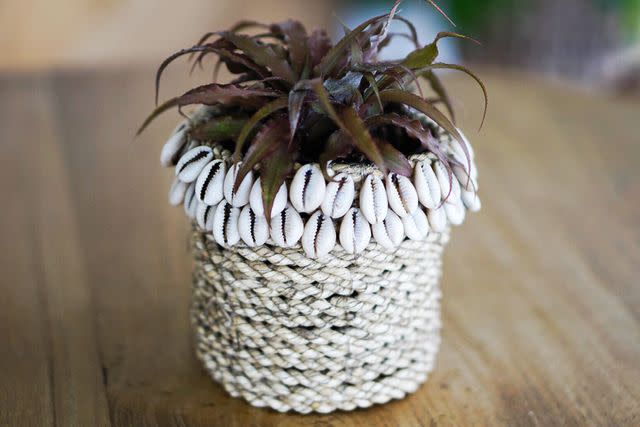
The Spruce / Gyscha Rendy
While planting in fabric pots may seem counterintuitive, indoor and outdoor plants seem to love them, and there are more and more on the market. One excellent choice is the Smart Pot—breathable fabric pots that "air prune" plants so they don't become root bound. They are lightweight, highly durable, and at the end of the season, you simply hose them off, fold them up, and put them away. They also come in multiple sizes. To jazz them up, you can put them in colorful, inexpensive laundry baskets.
Reusable grocery bags can also be used to grow plants outdoors. Better choices include bags that are a blend of plastic and textile fibers; plants thrive in these, as those made entirely of fabric often don't hold up for the entire growing season.

